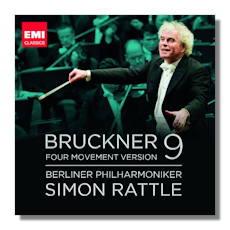
The Internet's Premier Classical Music Source
Related Links
- Bruckner Reviews
- Latest Reviews
- More Reviews
-
By Composer
-
Collections
DVD & Blu-ray
Books
Concert Reviews
Articles/Interviews
Software
Audio
Search Amazon
Recommended Links
Site News
 CD Review
CD Review
The title of this important release is somewhat is a misnomer, since properly speaking there is no four-movement version of the 9th Symphony composed by Anton Bruckner. There are several editions of the three more or less completed movements ("more or less" because Bruckner never finished revising them), the most recent being the 2000 edition by Benjamin-Gunnar Cohrs (and used in this recording). There is the "Documentation of the finale fragment", edited by John A. Phillips. The Documentation-Score gives the fragments that remain of the unfinished finale. As played by Nicolaus Harnoncourt in his 2002 workshop performance at the Salzburg Festival (RCA 54332), the Documentation-Score yields about 18 minutes of music, with some very significant gaps (including the whole of the coda). Finally, there is a "performing version" with the so-called SPCM completion, reconstructed and, to be frank, in places composed by Nicola Samale, John A. Phillips, Benjamin-Gunnar Cohrs, and Giuseppe Mazzuca. It is this performing version that is recorded for the first time here by Simon Rattle and the Berlin Philharmonic.
Rattle is not a prolific recorder of Bruckner symphonies, with extant recordings of the 4th, 7th, and 9th. On the evidence of this recording, though, he has great empathy with Bruckner's musical language and unique conception of musical architecture. The three movements that Bruckner actually composed in toto are very convincingly played.
The first movement is one of Bruckner's most complex, and Rattle manages to bring out the multiple themes of the Statement/Exposition with great clarity. (I am convinced by Robert Simpson that the terminology of Statement and Counter-Statement is much more appropriate than the language of traditional sonata form.) The Counter-Statement displays the right combination of grandeur and momentum, and the whole movement is wonderfully paced.
The Scherzo is a little less successful. Rattle and the Berlin Philharmonic project energy and dynamism, but much of the movement lacks the edge required to set up the tensions that the Adagio begins to try to resolve. Things pick up in the final appearance of the Scherzo, however, and the Adagio is well set up.
The Adagio is wonderfully played, from an acoustic point of view. Bruckner created extraordinarily beautiful sounds, and this recording more than does them justice. At the same time, though, there are moments when expressive depth is sacrificed to beauty of sound. The Adagio, and the symphony as a whole, displays some revolutionary and jarring dissonances. Truly great performances, to my mind, are structured in a way that places the dissonances at the center of the symphony's emotional landscape.
These reservations should not detract from Rattle's achievement in the first three movements. The performance is very good indeed, but what about the completion?
Here is an autobiographical report. After listening to the full performance on several occasions, and the completed fourth movement on its own on several more, I found long stretches of music that truly matched the first three movements in depth and originality and showed what Bruckner was planning as a counter-balance to the first movement. There are wonderful themes, adventurous harmonies, and challenging formal developments. I was not convinced by the totality, however. There are significant stretches when the music sounds generically "Brucknerian", without the compelling sense of inner logic and bold experimentation that characterizes Bruckner's finest movements – the coda, almost completely composed by the SPCM quartet, is a case in point. The interesting comparison is with the Documentation-Score, as recorded by Harnoncourt. I felt that more is lost by going from the Documentation-Score, incomplete though it is, to the performing version, than is lost by going in the other direction.
To conclude, there are two parts to this CD. The first is a very good, but not truly great, performance of the three movements that remain of Bruckner's 9th symphony. The second is a reconstruction of the fourth movement. Each is valuable and certainly worth listening to (the first three movements in particular). I remain unconvinced, though, of the wisdom of putting them together as a single performance.
Copyright © 2012, José Luis Bermúdez






















